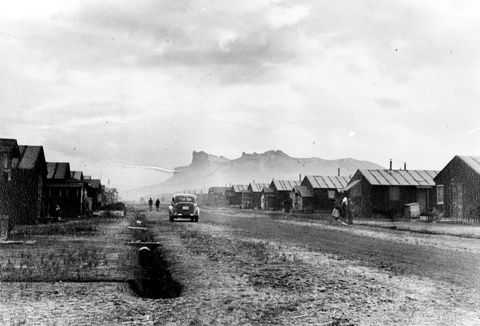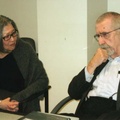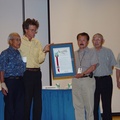Read Part 1 >>
Martial Law
With most of the elected Nikkei leadership imprisoned in the stockade, Commander Austin made plans for a mass public meeting on November 13, 1943 to be attended by the Army and WRA and the Negotiating Committee. This mass meeting never materialized as the prisoner population did not show up. Only the Army and WRA were present; they conducted their program without an audience. Commander Austin made proclamations to govern operation of the center, which, in effect, placed the Center under martial law.1 The Army then took over the camp with machine guns and tanks, searching for other dissident Nikkei leaders who were hidden within the confines of the center.
When the Army sought to arrest the seven members of the Daihyo Sha Kai Negotiating Committee, five of them, George Toshio Kuratomi, Shizuo Kai, Ichiro Hayashi, Mitsuho Kimura, and Isamu Sugimoto, went into hiding. To locate them, the 1,000-man Army Battalion conducted a dragnet through the entire residential area. The sweep found only Isamu Sugimoto; the remaining four members of the Negotiating Committee remained hidden in camp barracks by other inmates.
The military dragnet yielded little, but terrorized and angered the imprisoned population. Tiny apartments were invaded and privacy violated by soldiers who sifted through and reportedly stole valuables and personal possessions in the search for contraband.2 The continuing Army dragnet prolonged the hardship for Nikkei inmates, leading the four fugitives to surrender to the FBI on December 1, 1943.3 With their surrender, the Negotiating Committee, including the elected leadership of the center’s Japanese American population, the Daihyo Sha-kai, were imprisoned along with over 250 men in the stockade and held for months with no charges, no sentences, and no legal representation.4
Military personnel strictly controlled all movement in the residential areas. As a result, 90 more people were picked up and put in the stockade, 284 radios were taken, and food believed to be the property of the WRA was confiscated from Nikkei inmates, including 33,550 pounds of rice.5 The confiscated food was held in the warehouses and 54 individuals cited for violations of Federal law. The U.S. Attorney in San Francisco, Frank Hennessey, declined to prosecute after determining the food caches were the result of hoarding by people fearing food shortages, rather than theft.6
With the Center under martial law and patrolled by military personnel, with hundreds imprisoned in the stockade, on January 14, 1944, the Selective Service system announced that Japanese Americans were now eligible to be drafted into the Army. At Tule Lake, most refused to appear for their physicals, and 27 were arrested by the FBI for violation of the Selective Service Law. The Tule Lake draft resisters were tried for these violations, even though they were actually defined as “non-acceptable” to the War Department.7
Chaos, Conflict, and Mismanagement in the Segregation Center
In the aftermath of the November 4 events that led to Army occupation of Tule Lake, the FBI began documenting the turmoil at Tule Lake. The reports gave background on the nature of the conflicts, the international situation and the activities of Japanese patriots. Other reports scrutinized WRA personnel problems, black market activities of WRA staff, problems of internal security, and the Army’s use of “third degree” methods against prisoners.8
The camp suffered from constant staff turnover. “There have been three different administrations at the Tule Lake Center during the past year and a half,” the FBI reported. “As a result different personnel and administrative policies existed. There has also been a large turnover of personnel at the Center.”9 The WRA vacillated and changed policies, “from day to day, which would serve to keep the Center in a continual state of misunderstanding and unrest,” reported the FBI.10 “Each time the policy was changed confusion existed not only among the Japanese, but among the administrative personnel as well. As no explanation was ever made to the population, they were in a constant state of indecision.”11
The internal policing of the Center was ineffective. A primary problem appeared to be the quality of personnel in the WRA and the Army. The Chief of the WRA’s Internal Security Section told the FBI that the Caucasian police were issued guns, but not allowed to carry them in the Center because “a majority of men were not qualified to carry a gun; that the police personnel were of ‘poor grade,’ and that he has had to fire as many as six in one day.” Captain Hartman of the Military Police described low morale within a police force consumed with internal conflicts. Working relationships were so dysfunctional that “members of the force were keeping diaries on each other’s movements in attempts to ‘pin something’ on their superiors so that these latter individuals might be removed and, in turn, make way for their own advancement.”12
Public safety suffered and inmates had little faith in the ability of the Internal Security Section to protect them. During July 1944, there were two cases of rape within the Center, but they went unreported. “Neither of these cases had been referred to the Administrative Police for the reason that the Japanese no longer respect the police,” explained Captain Hartman, citing an earlier incident. “In a recent complaint of rape, the police were unable to take any effective action except to publicize the incident and embarrass the girl and her family.”13
Internal Security relied on Nikkei inmates for law enforcement within the colony, but after eleven incidents of violence that took place in June and July 1944,14 including the unsolved July 2 murder of co-op head Yaozu Hitomi, the Nikkei Colonial Police Chief and Assistant Chief resigned.15 The remaining 72 inmate wardens then resigned en masse, leaving the Internal Security police force with 40 Caucasian police for a community of 18,000.16 Although Project Director Best attempted to reestablish a new Community Police force of inmate wardens, Nikkei inmates felt that becoming a warden automatically branded them as collaborationist “inu,” i.e., people who sniffed about like dogs, spied on friends and neighbors, and could not be trusted because of loyalty to their keepers. Thus, by August 8, only 53 of 74 blocks had selected the two wardens allotted per block.17 The WRA eventually was able to fill the inmate warden positions, but according to the WDC, the wardens sympathized with the pro-Japan re-segregationists and refused to investigate problems resulting from the Center’s political factionalism.18
In addition to an ineffective police force, the pervasive gambling and alcohol abuse contributed to the overall sense of lawlessness.19 With 7 or 8 gambling operations operating brazenly in the Center, it is puzzling that the literature attributes violence and gang intimidation not to the thousands of dollars of losses and gains that occurred monthly as a result of the gambling and drinking, but to the Hoshi-dan forcing others to renounce. In fact, five representatives of the Hokoku Hoshi-dan wrote to Director Best on December 16, 1944, following up an earlier letter sent November 27, 1944, complaining about the lawlessness in the Center, with attacks and violence by “gangsters” carrying weapons. The letter requested that Internal Security investigate the illegal activities, and requested that the manufacture and sale of liquor be prohibited and that gambling and profiteering be prohibited.20 However, the WDC chose to ignore the complaint, viewing it as a smokescreen by the devious Hoshi-dan seeking to blame others.
Notes:
1. Supplemental Report, page 90-92.
The Army proclamation declaring martial law contained the following provisions:
- Between 7 pm and 6 am, everyone must remain in their residence.
- No outdoor meetings or gatherings without express military approval.
- Center operations shall be maintained under military control.
- Those who wish to work shall be accommodated as the situation permits.
- No incoming or outgoing telephone messages without prior military approval.
- Failure to observe strict adherence to all military regulations will result in disciplinary action.
- All persons of Japanese ancestry shall reside in the apartments assigned to them by WRA. (Previously, people moved at will making it difficult for the WRA to keep track of everyone.)
2. Supplemental Report, page 93.
The Army discovered two radio stations and shut them down even though the WDC was aware that the transmitting equipment was capable of broadcasting only a 50-mile radius and “could not have been used for the purpose of espionage.” A large collection of Japanese music records broadcast over the radio stations were also confiscated because they seemed to be “very pro-Japan in character.”
3. FBI Report, August 2, 1945, page 126
4. FBI Report, August 2, 1945, page 139
The stockade population December 9, 1943 disclosed 233 individuals of Japanese ancestry in custody. Of that number, 217 were citizens and 16 Issei.
Hawaiian Kibei –151
Transfers from Leupp AZ – 52
Political leaders – 16
Arrested night of Nov. 4 – 8
Curfew violators – 2
Misc. not stated – 4
Total in detention – 233
5. Supplemental Report, page 94.
6. FBI Report, August 2, 1945, page 126
7. Supplemental Report, WDC, page 103-04. The Supplemental Report describes this as “a comedy of errors for the Military Clearance Section of G-2 had notified the Selective Service Boards of these individuals that they were not acceptable to the Armed Forces. However, either through error, or through a misguided conception of their own power, the Selective Service Board sent their names in for induction and the NSC carried out their duties as to furnishing physical examinations. On their refusal to appear for the examination, the Selective Service Boards requested that the FBI arrest them for these violations. The Military Clearance Branch of G-2 was never consulted by the FBI or the NSC, and therefore, these people were tried, although they were actually non-acceptable to the War Department. Under the circumstances, it is obvious that the Judge’s decision was correct.”
8. FBI Report, August 2, 1945, page 146-163
9. FBI Report, August 2, 1945, page 146
10. FBI Report, August 2, 1945, page 183.
11. FBI Report, August 2, 1945, page 138.
12. Commission on Wartime Relocation and Internment of Civilians files. (CWRIC) Document 23206-23214. National Archives II, College Park, MD. Memo to the Director, October 4, 194462-70564-303, re: Control of the Center.
13. FBI Report, August 2, 1945, page 184.
14. FBI Report, August 2, 1945, Page 188-190.
The violence that took place during June and July 1944 led Lt. Col. Austin to state, “that the Center was in a state of turmoil.”
May 25, Shoichi James Okamoto fatally shot by Private Goe. According to Austin, “the WRA immediately assumed the role of protector of the Japanese against the ‘big bad Army’ and attempted to minimize the authority of the Army…. WRA officials offered to donate blood and to subscribe to a fund to purchase flowers.”
June 3, Henry Beppu beaten with a club by four unidentified Japanese.
June 7, Harry Hiroshi Kawai attacked a soldier with the blunt edge of a meat cleaver. The soldier was taking pictures in the Japanese section and an inebriated Kawai was attempting to hit the soldier’s camera.
June 10, H. Hitomi, brother of Yaozo Hitomi, was attacked by several Japanese and received head injuries.
June 13, Sakutaro Morimoto, member of the Colonial police, was attacked and injured by four Japanese.
June 26, Sigeo Okamoto attacked Sononuki Suzuki, his roomate, and Shunzi Tanaki with a hammer. Okamoto was later found to be insane.
July 2, Yaozo Hitomi, General Manager of the Tule Lake Cooperative Enterprises, was stabbed. On receiving report of the incident, Internal Security Officer did not go to the scene of the murder since it was near the end of his shift. The investigation waited until the next day, and the fingerprint impressions were not recorded as the blood had dried and cracked by the time of the investigation.
July 2, Aizo Takahashi was attacked by two Japanese.
July 2, person in charge of a baseball booth at the carnival was approached by a group, and beaten. When contacted by the Colonial Police, he told them it was none of their affair.
July 5, Kiyoshi Yamamoto beaten by unknown individuals.
15. FBI reports from Tule Lake 1944, August 17, 1944, 62-70564-297, page 37. Also, CWRIC Box 22, file pages 22842-22903. An FBI informant stated “many of the recent attacks have been made on persons who opposed the gamblers and bootleggers and those who are known or believed to associate too closely with Caucasians and the WRA.”
16. FBI Report, August 2, 1945, page 185.
17. FBI Report, August 2, 1945, page 185.
18. Supplemental Report, page 106-07.
19. FBI Report August 2, 1945, page 191. See also, CWRIC Box 22, file pages 22842-22903, FBI Report from Tule Lake, August 17, 1944, 62-70564-297, page 39-40.
Gambling flourished and operated openly within the Segregation Center, with seven or eight known gambling houses in the Center as of July 1944. “Losses by some of the players are very heavy, and a man [redacted] recently lost $8,000 over a short period. There are other cases where one person has lost as much as $5,000 at these gambling houses. These losses have brought about family troubles and divorces and even a case of suicide by one Japanese wife.” The FBI source reported that gamblers had large amounts of money available for illegal activities, including bribing the Internal Security Force with $5,000 to cover their activities and be relieved of all molestation regarding gambling, bootlegging, and other illicit activities.
“The informant described one and two bottle lots of liquor are still coming into the center, after which they sell it for $18 per bottle. He stated he believed this smuggling was being carried on by the drivers of bread delivery trucks. According to this source, sake making is again rampant since the Army returned control of the center to the WRA. Since the commencement of sake making, a bag of rice is bought from the Cooperative stores for $7.50 a bag which will produce from twenty to twenty-five gallons of sake which retails for $7.50 a gallon.”
20. National Archives I, Washington, D.C. RG 210, Entry 48, Box 274, NND 802054, Tule Lake Relocation files 423-425.3
* This article was originally published in the Journal of the Shaw Historical Library, Vol. 19, 2005, Klamath Falls, OR.
* * *
* Barbara Takei will be a presenter for “The Tule Lake Segregation Center: Its History and Significance” session at JANM’s National Conference, Speaking Up! Democracy, Justice, Dignity on July 4-7, 2013 in Seattle, Washington. For more information about the conference, including how to register, visit janm.org/conference2013.
© 2005 Barbara Takei








